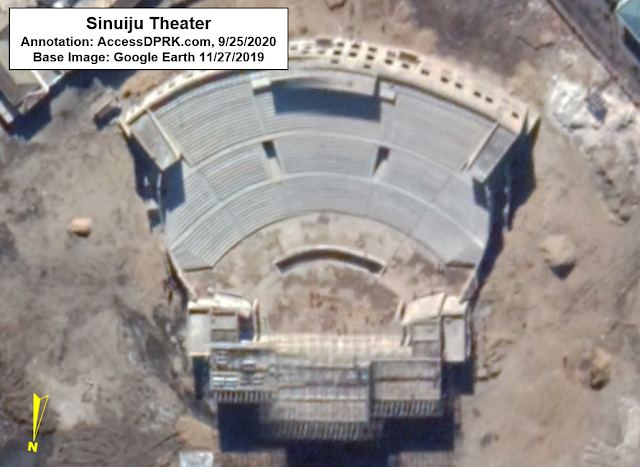A hallmark of Kim Jong Un's rule has been the creation of entertainment centers. Be they amusement parks, ski resorts, children's traffic parks, and even "4D" theaters, new recreational facilities have popped up all over the country.
Included in that mix are open-air theaters. Coinciding with the renovation of the Pyongyang Youth Open-air Theater, new theaters are under construction in nearly every provincial capital and some select other cities. In Chongjin, Haeju, Kanggye, Nampo, Pyongson, Rason, Sariwon, and Sinuiju, construction is well under way or nearly completed. Hamhung's theater is in the very initial stage of construction, and Wonsan already has an established open-air theater.
The construction of most sites began in 2018 but has yet to be fully finished at any of them except for the refurbished Pyongyang theater.
Plays and film have always loomed large in North Korean culture with nearly every town having a traditional movie theater built/rebuilt almost immediately after the Korean War. Kim Jong Il, especially, loved movies, plays, and opera. He wrote numerous letters and books on the subject, including On the Art of Cinema and On the Art of Opera. Each explaining in detail his views on the subjects and how they can best serve the state's goals through "socialist art" and as tools of indoctrinating the people with correct forms of thought.
And while everyone in the country knows they're being propagandized to, a lifetime of exposure has taught them to tune out the obvious stuff and enjoy the stories themselves. Indeed, North Korean's are quite the vocal art critics - in their subtle ways to avoid accidentally criticizing the regime. A good film, play, or song will rapidly make its way through the cities and into the countryside.
Soon after Kim Jong Un came to power, in recognition of the people's love of film, "4D-rythmic" theaters began to be built and now there's one in most large cities. With their distinctive architecture, they're easy to spot.
Participation in "mass-based art" has long been promoted with, "All provinces, cities, counties, industrial establishments and cooperative farms across the country have halls of culture, libraries and reading halls. Theatres and halls of culture in different parts of the country are equipped with facilities and musical instruments necessary for cultural and emotional life and artistic activities of working people." - Naenara, July 20, 2020
There is some variation in size with each of the new open-air theaters, ranging from 65-80 meters front-to-back and 85-100 meters at the widest. The existing Pyongyang theater is approximately twice the size as the newly built ones.
In the case of Sinuiju, there are 38 rows of seating arranged on three levels and into 13 sections. The Pyongyang Youth Open-Air Theater has seating for 10,000 and the theater in Haeju is said to have a seating capacity of 5,000. Given that Haeju is closer in size to the others, all of the new theaters probably have a seating capacity ranging from 5,000 to 7,000.
These theaters are also used for things other than plays and performances. Films can be shown, lectures given, and educational classes are provided. This not only makes them an important part of North Korean culture but they also provide the state with another venue for instilling propaganda and disseminating the wishes of the Korean Workers' Party.
The Pyongyang theater had a set of solar panels added to its roof. It is likely that the other new theaters will also include solar power. This fits in with the country's incremental adoption of green energy solutions to their otherwise extreme electricity shortage.
Provincial capitals usually have a handful of distinctive features (like joint murals of Kim Il Sung and Kim Jong Il) that other cities tend to lack. However, certain things eventually make their way into other important cities after their popularity has been assessed in the capitals. I wouldn't be surprised if these open-air theaters end up spreading to a few more cities in the coming years.
I would like to thank my current Patreon supporters: Amanda O., Andres O. GreatPoppo, John Pike, Kbechs87, Planefag, and Russ Johnson.






